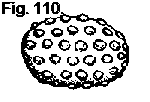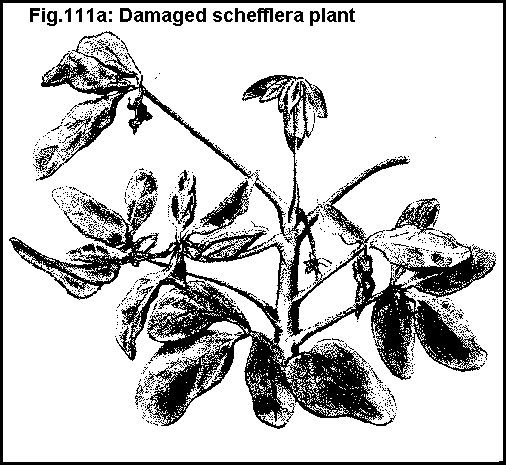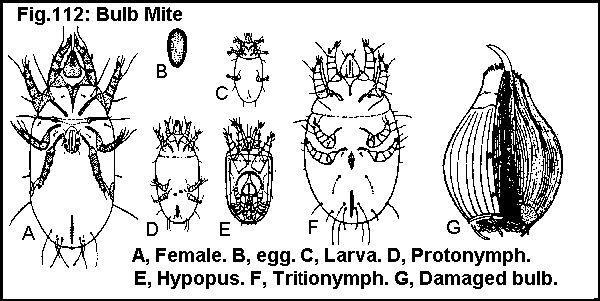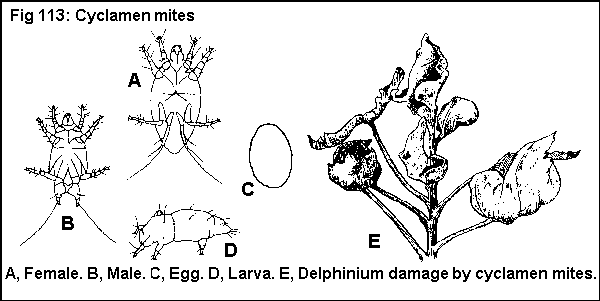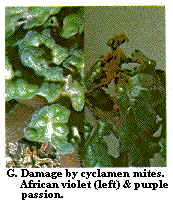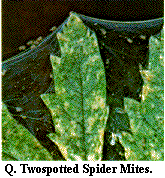Introduction
Although mites differ from insects in several ways, their damage to ornamental plants resembles that of thrips and lace bugs. Most mites have eight legs as adults (adult insects usually have six). Mites do not have wings (some adult insects have wings) but can be aerially dispersed by breezes and winds more or less like aerial plankton, particularly in hot, dry weather. It is thought the mouthparts (chelae) of mites evolved from legs with a prehensile joint, (the digitus mobilus) which allows the mite to chew with a vertical, scissors like action. In spider mites, broad mites, and cyclamen mites, the chelae have evolved into sharp mouthparts that mites use to pierce the surface of the plants they feed on in order to suck out the contents of the plant cells. Mites evidently inject saliva as they feed for one of the first symptoms of broad mite and cyclamen mite feeding is failure of the host plant to blossom. Infested plants then exhibit a variety of plant growth regulator symptoms including twisted and distorted growth, and shortened internodes and petioles.
Key to the Most Common Mites Found on Flowers and Foliage
- Mites visible to the naked eye; infested plant may be discolored but usually not distorted by feeding - GO TO 2
Mites not visible without at least a 10X hand lens; infested plants usually cease blooming and have shortened internodes, distorted leaves and stems, and blasted buds - GO TO 3 - Mites feeding on foliage and causing tiny chlorotic spots, mites sometimes accompanied by fine silk webbing - TWOSPOTTED SPIDER MITE
Mites feeding primarily in the bulbs of Easter lilies - BULB MITES - Egg oval, about 0.08 mm long, covered with minute white bumps (Figure 110); female translucent brown and about 0.2 mm long, shaped like a fat football - BROAD MITE
Egg oval, about 0.1 mm long, without minute bumps; female translucent brown, about 0.3 mm long, shaped like a skinny football - CYCLAMEN MITE
Broad Mite
Broad mite (Figure 111), Polyphagotarsonemus latus (Banks),Tarsonemidae, PROSTIGMATA
DESCRIPTION
Adult
Broad mites are almost microscopic (less than 0.2 mm long). They are translucent and colorless to pale brown. There are four pairs of legs; the last pair in the female ends in a long hair; the last pair on the male ends in a strong claw.
Egg
The egg is elliptical, translucent, colorless, about 0.08 mm long, and is covered by 29 to 37 whitish bumps.
Larva
The young broad mite has three pairs of legs and is whitish due to minute ridges on the skin. It is about 0.1 mm long.
BIOLOGY
Distribution
The broad mite is found in India, Sri Lanka (where it is called the yellow tea mite), Bangladesh (where it is called the yellow jute mite), Romania (where it is called the broad spider) and other European countries, Africa, Brazil (where it is called the tropical mite and the broad rust mite), and the United States.
Host Plants
Broad mites feed on a large number of field crops, including potato, tomato, chili, cotton, mango, papaya, and tea. Broad mites also infest African violet, ageratum, azalea, begonia, dahlia, gerbera, gloxinia, ivy, jasmine, impatiens, lantana, marigold, peperomia, snapdragon, verbena, and zinnia.
Damage
Infested plants become unthrifty. Leaves curl downward and turn coppery or purplish. Internodes shorten and lateral buds break more than normal. This new growth may also be stunted or killed which forces out additional shoots (Figure 111A). Flowers are distorted and fail to open normally. Unless controlled, broad mites usually destroy the commercial value of infested ornamental corps. Broad mites damage flowers and foliage of begonia and cyclamen, and bronze the lower leaf surfaces. Broad mites are so small that they are virtually invisible on the host plant even with a good hand lens. Also the mites tend to crowd into crevices and buds and feed on the growing tips. Their toxic saliva causes twisted, hardened and distorted growth in the terminal of the plant. The effects of their feeding may persist long after the mites have been eradicated.
Life History
Female broad mites lay 30 to 76 eggs on the leaf surface over an 8- to 13-day oviposition period. Unmated females lay male eggs; mated females usually lay four female eggs for every male egg. The larvae hatch in 2 or 3 days and emerge from the egg shell to feed. Larvae are slow moving and do not disperse far. In 2 or 3 days, the larvae develop into a quiescent larval stage. Quiescent female larvae become attractive to the males which pick them up and carry them to the new foliage. Males and females are very active, but the males apparently account for much of the dispersal of a broad mite population in their frenzy to carry the quiescent female larvae to new leaves. When females emerge from the quiescent stage, males immediately mate with them. Males live 5 to 9 days; females live 8 to 13 days.
CONTROL
Broad mites are very sensitive to heat. Lowering infested plants into water held at 43 to 49°C for 15 minutes will destroy broad mites without damaging the plants. Broad mites are also susceptible to various miticides. However, they are more difficult to control in winter than in summer due to lower greenhouse temperatures. For specific chemical control recommendations, see the current Cooperative Extension publications on ornamental plant pest management or consult your county Extension agent.
Bulb Mite
Bulb mite (Figure 112), Rhizoglyphus echinopus (Fumouze and Robin), Rhizoglyphus robini Claparede, Rhizoglyphus hyacinthi Banks, or Rhizoglyphus engeli v. Eijndhoven, Acaridae, ACARI
DESCRIPTION
Adult
Mature bulb mites vary from 0.5 to 0.9 mm long and have four pairs of legs. Their bodies are shiny, white, somewhat transparent, and smooth with reddish brown appendages.
Egg
The egg is white and translucent, 0.12 mm long, and ellipsoidal.
Larva
Shortly after hatching, the larva is 0.15 to 0.2 mm long and when well developed is 0.25 mm long. White and oval, larvae have only three pairs of legs and lack genital suckers.
Protonymph
The protonymph has four pairs of legs; it is oval and approximately 0.4 mm long. This stage can be distinguished from the tritonymph by having two genital suckers, whereas the tritonymph has three or four suckers.
Deutonymph or Hypopus
This quiescent stage is oval, convex on top, flattened below, brown, and 0.2 to 0.3 mm long. The mouthpans are absent. On the back lower side is a conspicuous sucker plate.
Tritonymph
The tritonymph is about 0.5 mm in length and has not yet developed a distinct genital aperture.
BIOLOGY
Distribution
From their original discovery in Europe, bulb mites have now been found throughout the United States, Canada, Japan, and the Bermuda Islands. These mites are easily transported in shipments of infested bulbs.
Host Plants
Bulb mites have been recorded feeding on forced iris, lily, narcissus, Gloriosa, Hippeastrum, Eucharis, orchid, hyacinth and tulip bulbs, dahlia tubers, and freesia and gladiolus corms. These mites also infest vegetable bulbs.
Damage
Bulbs infested with bulb mites may rot and fail to produce new growth, or new growth may be off color, stunted, and distorted. Although the bulb mite is not considered a primary pest of bulbs, it is often responsible for serious losses; the slightest injury to a bulb will allow bulb mites to enter and become established. Once the mites are inside the bulb, they rapidly turn the bulbs into rotten pulp. Infestations of the bulb mite generally indicate that the bulbs have already been injured. This damage could have been caused by other pests, such as the bulb scale mite or bulb flies, mechanical injury, or improper storage. The root primordia of freesia and gladiolus may be bruised at planting. Apparently bulb mites can attack healthy new roots and corms, especially in greenhouses. The mites may penetrate into lily stems which become brittle. Infested lilies are often dwarfed, distorted, and the stem roots are suppressed. Bulb mites attack the young root tips of Hippeastrum and Eucharis. When bulb mites attack Gloriosa, the new tubers get numerous small cavities and tunnels and become distorted. Bulb mites may enter prematurely opened tulip buds (due to high storage temperatures or ethylene generated by diseased bulbs in storage) and cause bud necrosis.
Life History
Bulb mites are rarely noticed as isolated individuals, but rather as large colonies. All stages of the mite can be found throughout the year. Development may occur in five or six stages (a hypopal stage is sometimes produced). In those forms with six stages, the life cycle proceeds from egg to larva to protonymph to hypopus to tritonymph to adult.
Females lay up to 700 eggs each depending on the host. R. robini tends to form relatively small colonies on narcissus and tulips whereas R. echinopus forms large colonies on a greater range of bulb crops. These mites can survive by feeding on paper and other sources of organic matter. The eggs mature in 5.1 to 27 days. The total life cycle from egg to adult could be as short as 12.2 days (at 25°C) for R. robini or 13.9 days (at 25°C) for R. echinopus depending on the host bulb, temperature, and relative humidity. Adults live longer at lower temperatures (up to 121 days) and males tend to live twice as long as females. These mites can survive at 35°C, but they cannot lay eggs at that temperature. On the other hand these mites cannot develop at temperatures below 11.8°C. The length of development is greatly dependent on temperature, relative humidity (100 percent is best), and available food. Hypopi form when the population becomes crowded, or the substrate becomes too polluted by decay. The hypopal stage attaches to insects visiting the bulbs and may be carried to other bulbs. Hypopi do not feed (no head), and they are resistant to starvation and desiccation during adverse conditions. The ratio of males to females varies from 1 to 1, to 1.9 to 1, depending on relative humidity, diet, and perhaps other factors. Besides their direct feeding, bulb mites are a threat because they carry pathogenic fungi.
CONTROL
It is very important to avoid rough handling of bulbs to prevent injury that might afford an entry point for fungi and bulb mites. Bulb mites cannot withstand drought and dry bulbs in storage are usually not attacked (unless mites are already deep inside tissue). Bulb mites are very tolerant of a number of synthetic pesticides apparently due to active oxidases, esterases, and transferases that detoxify such chemicals. Flooding gladiolus corms for 5 days gave 96.1 percent mortality; 14 days gave 100 percent mortality. A predaceous mite, Cosmolaelaps claviger, feeds readily on R. echinopus and other soil organisms. R. robini has an alarm pheromone, citral, which although not toxic to the mites, was definitely repellent. These mites left bulbs treated with citral at 100 ppm, and a mixture of citral and a miticide gave significantly better control of R. robini than the miticide by itself. Evidently the alarm pheromone made the mites more active and increased their contact with the pesticide. Soaking bulbs in a miticide before planting has been shown to prevent bulb mite injury. Steam sterilization and methyl bromide at low concentrations eliminated the mites from soil. For specific chemicals and control methods see your county Extension agent or consult your state's management guide for ornamental plant pests.
Cyclamen Mite
Cyclamen mite (Figure 113), Stenotarsonemus pallidus (Banks), Tarsonemidae, ACARINA
DESCRIPTION
Adult
These mites are tiny animals, less than 0.3 mm long. Colorless or brown tinted and waxy looking, they have four pairs of legs. The fourth pair of the female is slender with a long, hair extending from the tip. The fourth pair of legs of the males ends in a strong claw.
Egg
The elliptical egg is 0.1 mm long and smooth.
Larva
The young mites are about 0.2 mm long and are whitish and have three pairs of legs. The legs have microscopic claws and suction cups.
Quiescent Stage
This stage appears as an immobile, engorged larva.
BIOLOGY
Distribution
The cyclamen mite is found throughout the United States and Europe.
Host Plants
African violets are most often damaged by cyclamen mites. They also have been found on ivy, snapdragon, chrysanthemum, larkspur, geranium, fuschia, begonia, petunia, daisy, and azalea.
Damage
Cyclamen mites cause tuberous begonia and cyclamen flowers to be discolored or to shrivel or wilt. Infested flowers may not open properly or may not open at all. The mites also cause puckering, crinkling, and curling of leaves; infested leaves become brittle (Figure G). Infested cyclamen buds fail to open or the flowers are distorted.
Life History
Cyclamen mites were first reported in the United States about 1900. It has since become famous as a harmful plant pest. Cyclamen mites seem to avoid the light; they occur in hidden areas on plants (buds and between the calyx and corolla and the stamens and ovaries of flowers). This mite also prefers high humidity. The eggs have delicate shells that can often be found collapsed among masses of unhatched eggs and mites. Deposited in moist, dark places and in small groups, the eggs require about 11 days to hatch. The mites molt only once. New larvae have wrinkled skin that stretches as they grow. They are highly active for about one week, after which they enter a quiescent stage for a few days and then molt to the adult stage. Each day the female lays two or three eggs. Eggs are relatively large in comparison to the adults. Cyclamen mites often exist wherever old cyclamen corms are preserved in the greenhouse. If a suitable host is not present year-round, female mites may semihibernate in the soil until a host becomes available. Females are usually more abundant than males in the winter months, and they live longer than males.
CONTROL
Immersing infested plants (pot and all) into water heated to 43°C for 15 minutes kills cyclamen mites without harming most plants. If chemical control is desired, spray or dip the plant thoroughly with a miticide. For specific chemical control recommendations, see the current Cooperative Extension publications on ornamental plant pest management or consult your county Extension agent.
Twospotted Spider Mite
Twospotted spider mite (Figure 114), Tetranychus urticae Koch, Tetranychidae, PROSTIGMATA
DESCRIPTION
Adult
The eight-legged adult can be pale green, greenish amber, or yellowish. Usually having two (sometimes four) black spots on top, the twospotted spider mite is about 0.4 mm long.
Egg
The spherical egg ranges from transparent and colorless to opaque straw yellow.
Larva
The six-legged larva is colorless, pale green, or yellow.
Nymph
Similar to the adult except in size, the nymph has eight legs and is pale green to brownish green. Large black spots may develop on each side.
BIOLOGY
Distribution
Twospotted spider mites are widely distributed in the United States. Reports have shown the Piedmont and Coastal Plain regions of the Southeast to be the most heavily infested areas.
Host Plants
Twospotted spider mites have been reported on more than 300 host plants, that include over 100 cultivated species. Violets, chickweed, pokeweed, wild mustard, henbit, vetch, and blackberry are common foci from which infestations develop on nearby crops.
Damage
Twospotted spider mites pierce the epidermis of the host plant leaf with their sharp, slender mouthparts. When they extract the sap, the mesophyll tissue of the leaf collapses in the area of the puncture. Soon a chlorotic spot forms at each feeding site. After a heavy attack, an entire plant may become yellowed, bronzed, or killed completely. The mites may completely web over entire plants (Figure Q).
Life History
Twospotted spider mites are important pests on more crops than any other arthropod in the Southeast. Though insects and mites are in a group called the Arthropoda (meaning jointed foot) because jointed legs are common to both, spider mites are not actually insects. They are more closely related to spiders, and they derive their name from the thin web which some species spin.
In North Carolina, twospotted spider mites overwinter as adults in the soil or on weed hosts such as violets, henbit, and hollyhocks. In mild winter weather, twospotted spider mites continue to feed and lay eggs, although development in the winter is much slower than in the summer. From the eggs hatch six-legged larvae. They develop into eight-legged nymphs, which pass through two nymphal stages. After each larval and nymphal stage, there is a resting stage. The adults mate soon after emerging from the last resting stage, and in warm weather the females soon lay eggs. Each female may lay over 100 eggs in her life and up to 19 eggs per day. Development is rapid in hot, dry weather. Each generation may take as many as 20 or as few as 5 days to mature.
They often damage one species of plant quite heavily and then disperse to other hosts. When a plant is heavily damaged, the mites migrate to the outer periphery of the plant. From here, even the gentlest of breezes can carry them a significant distance to attack new hosts.
CONTROL
The use of foliar insecticides in hot, dry weather can induce spider mite outbreaks by killing the beneficial arthropods that would normally feed on the mites. In addition, a fungal pathogen attacks spider mites following short periods of cool, damp weather. Certain fungicides can eliminate this fungus and should be avoided for several weeks if plants are infested and such conditions occur. If spider mite infestations are detected early enough, a daily misting or spraying with a garden hose can be an effective control.
The resting stages and eggs of the twospotted spider mite are more tolerant to pesticides than the motile forms. Consequently, a second application of pesticide may be necessary at 4- or 5-day intervals in hot weather (7 to 10 days in cool weather) to kill those mites that may have survived the first application. For specific chemical control recommendations, see Cooperative Extension publications on ornamental plant pest management or consult your county Extension agent.
Publication date: Jan. 1, 1994
AG-136
Other Publications in Insect and Related Pests of Flowers and Foliage Plants
- Aphids Found on Flowers and Foliage
- Beetles Found on Flowers and Foliage
- Bugs Found on Flowers and Foliage
- Caterpillars Found on Flowers and Foliage
- Flies and Maggots Found on Flowers and Foliage
- Leafhoppers Found on Flowers and Foliage
- Mealybugs Found on Flowers and Foliage
- Mites Found on Flowers and Foliage
- Scale Insects Found on Flowers and Foliage
- Slugs and Snails Found on Flowers and Foliage
- Thrips Found on Flowers and Foliage
- Whiteflies Found on Flowers and Foliage
N.C. Cooperative Extension prohibits discrimination and harassment regardless of age, color, disability, family and marital status, gender identity, national origin, political beliefs, race, religion, sex (including pregnancy), sexual orientation and veteran status.

